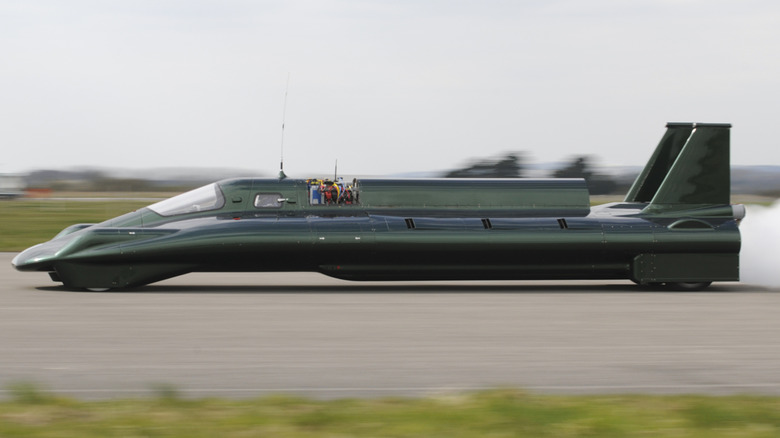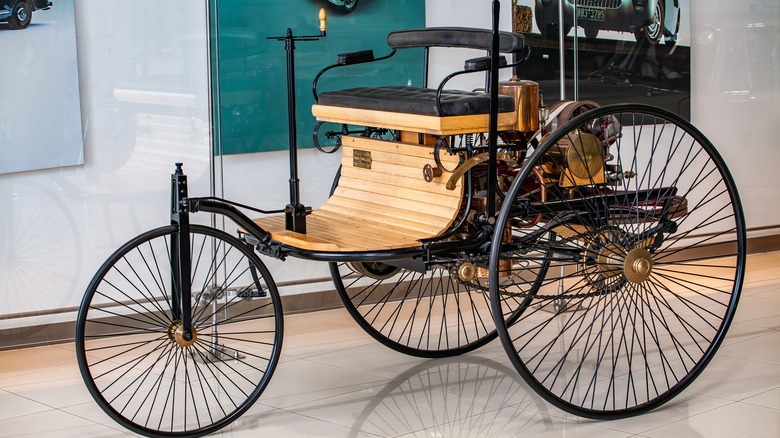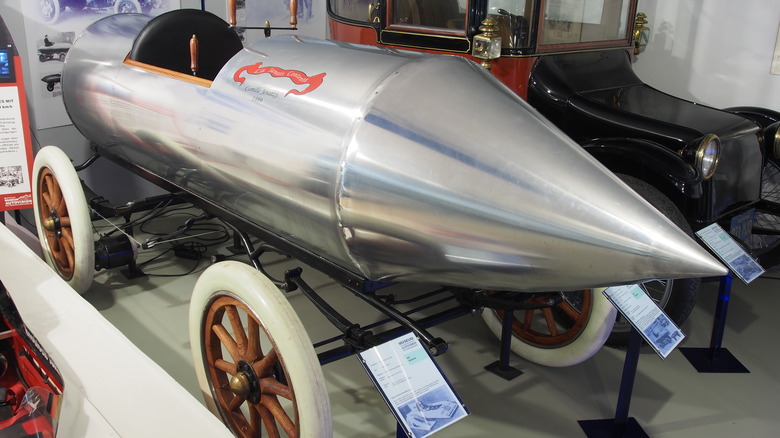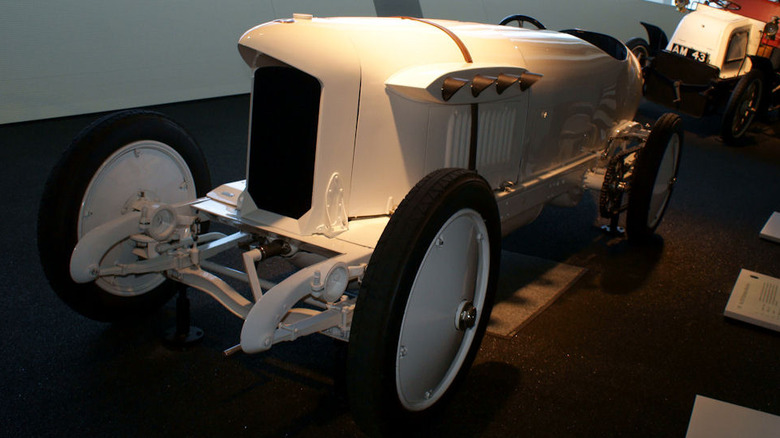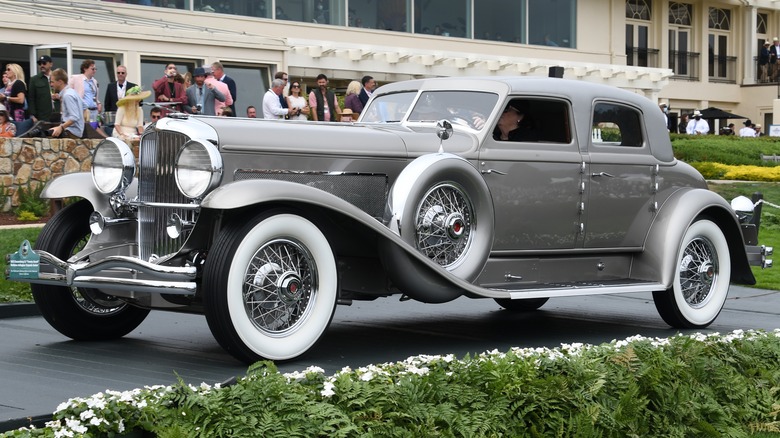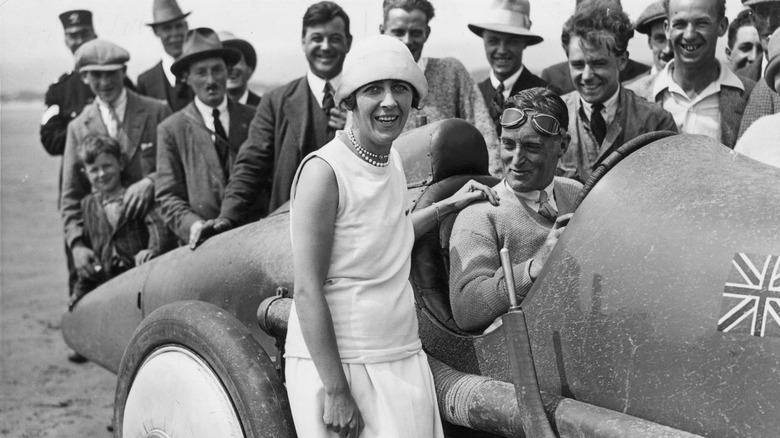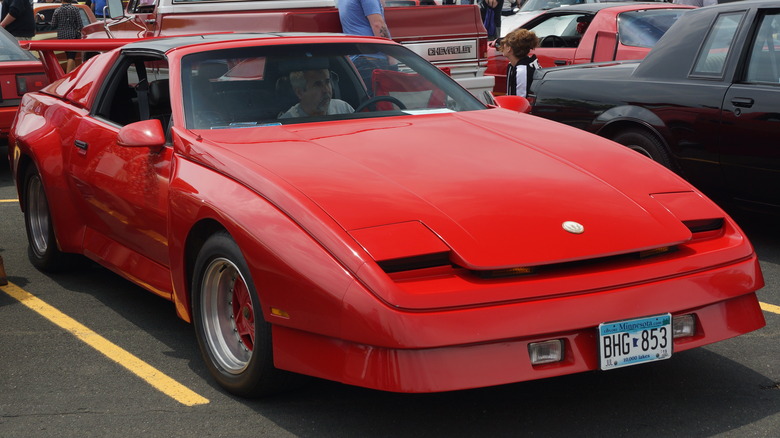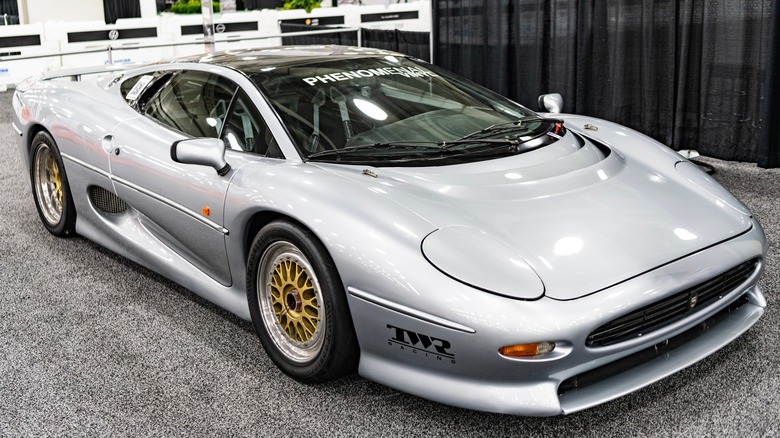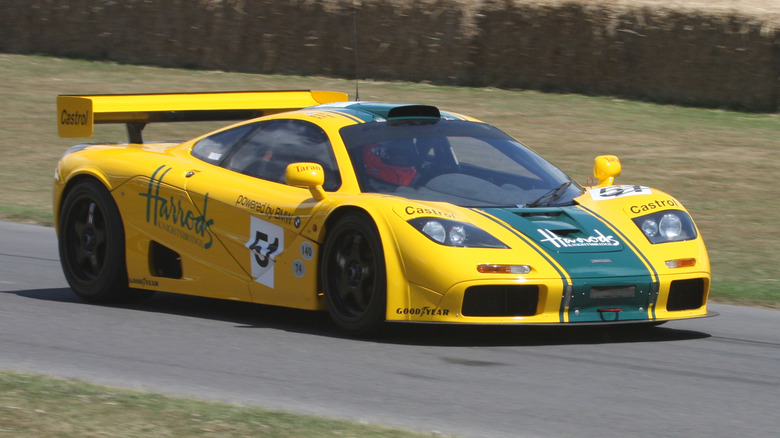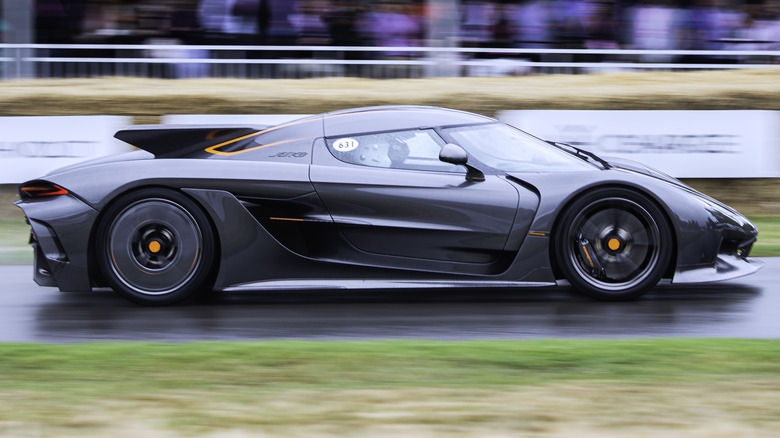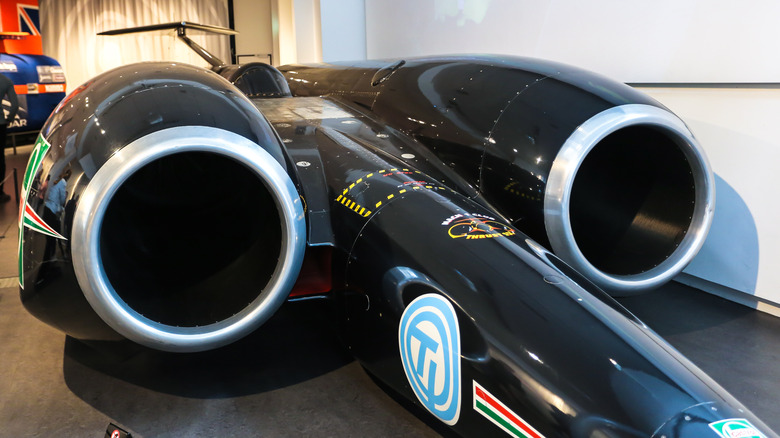10 Cars That Once Held The Title Of Fastest In The World
Humanity has been obsessed with speed since far before the automobile. If it moved, people wanted to see how fast it could go, whether by horsepower, wind power, or just plain old-fashioned ambulation. In the industrial era, that obsession with speed translated into racing of all types, whether by sea, air, or land.
Those who care about speed records tend to be competitive. Everyone wants to be the fastest in the world. There are many ways to measure speed, and auto enthusiasts are obsessed with them. Who can accelerate the fastest? What about top speed? Performance cars are even measured by how fast they can stop.
As the 20th century progressed, the land speed record became increasingly the domain of specialized teams and builders. But there is another important category: the fastest production car. After all, what fun is the fastest car in the world if the average car nut can't get their hands on it?
Whether built for the express purpose of shattering the land speed record or by automakers who wanted to own the fastest production car title, we look at some of the most iconic vehicles in history that laid claim to the top speed in the world.
Benz Patent-Motorwagen: 10 mph: 1885
The name Benz has been attached to some of the most outrageous performance vehicles in history, from the 2025 AMG C63 S E Performance all the way back to the Benz Patent-Motorwagen. Sure, a good horse could outpace it, but this wasn't the fastest car because of it's blazing speed — it was just the only car.
German engineer Karl Benz introduced the internal combustion-powered tricycle in 1885 from his shop in Mannheim, Germany. Others experimented with an alternative to the good old horse and carriage combo before, but the Motorwagen is widely accepted as the first practical self-propelled vehicle.
Benz's initial contraption may have been tough to handle (it crashed into a wall during a demonstration — no word on injuries). It may have rattled, popped, and smoked like a steampunk nightmare and needed some assistance conquering a gentle slope. But once it got to the top, that downhill leg could see the Motor Wagen pulling itself to a screaming 10 mph (never mind the jogger outpacing you).
Let's get to the meat of the matter: the powerplant on this bad boy. A single-cylinder four-stroke engine made ¾ of a horsepower. Seriously, a good horse would be way better. But it doesn't matter because this is the one that started it all.
La Jamais Contente EV: 65 mph: 1899
When a French newspaper proposed a speed contest in 1899, it sparked a rivalry that would set six speed records in four months. Frenchman Count Gaston de Chasseloup-Labaut, also known as the Electric Count, pushed his Jeantaud Duc EV to a 39-mph (63 km/h) run in December 1898.
The Electric Count's glory was brief. Belgian driver Camille Jenatzy came roaring out of Wallonia in a CGA Dogcart, eking out Chasseloup-Labaut's time and topping out at 41 mph (66 km/h). Not content to lose to a Belgian, the Electric Count pushed his EV up to 43.5 mph (70 km/h) the very same day.
Jenatzy retired to his shop, where he built one of the earliest vehicles designed for pure speed. Unlike the boxy Jeantaud Duc piloted by the Count, Jenatzy's La Jamais Contente (translation: The Never Satisfied) looked like a cross between a hot dog and a missile. A pair of 25-kilowatt motors delivered 68 hp, pushing Jenatzy up to 65 mph (105 km/h), capturing the land speed record.
The rise of standardized production and the cheap availability of oil soon put the brakes on the production of EVs. Le Jamais Contente's run heralded the end of the brief age of electric vehicles. This age has only recently undergone a renaissance, with game-changing breakthroughs on the horizon for modern EVs.
Blitzen Benz: 128 mph: 1910
The rivalry between the Electric Count and Jenatzy was a preview of the 20th century. By 1909, Benz was back in the mix, this time at the helm of a company named Benz & Cie, a producer of road cars.
Board member Julius Ganz fervently believed that record-breaking speed would help sell road cars — a notion held by automakers everywhere to this day. Though Benz did not initially agree, he permitted Ganz to pursue his strategy.
The Benz team, including designer Louis de Groulart, Hans Nibel, and French driver Victor Hemery, took a 150 hp four-cylinder engine out of a Benz Gran Prix car and bored it from 15.5 to 21.5 liters. The Blitzen Benz may be the physical manifestation of "there's no replacement for displacement." No Mercedes-Benz has reached such a gargantuan combustion capacity before or since, nor have even the biggest car engines sold in America.
The resulting engine weighed 897 pounds (407 kg) — nearly a third of the weight of the 3,200-pound (1450 kg) vehicle — but it produced 200 hp, and with that kind of power, a record-breaking moonshot was in the offing.
In October 1909, the Benz achieved its goal in the very first attempt. With Hemery behind the wheel, the Lightning Benz cracked the 124 mph (200 km/h) benchmark, hitting a speed of 128 mph (205.7 km/h ) over a half-mile straight-line run.
[Featured image by Valder137 via Wikimedia Commons | Cropped and scaled | CC BY-SA 2.0 ]
Duesenberg Model SJ: 140 mph: 1932
The Duesenberg Model SJ emerged in the 1930s as the fastest production car around. Founded in Minnesota by brothers Frederick and August, the Duesenberg name is synonymous with elegant coachwork and the beauty of a bygone era. But Duesenberg was also known for performance in its heyday. In fact, Fred and Augie were avidly interested in racing, so much so that they supercharged the engines that went into their cars.
Duesenberg's luxurious Model J hit the street in 1928. With a wheelbase between 142 and 153 inches, the lightest amongst the model Js weighed 5,500 pounds. Powered by a 420 cubic inch in-line eight-cylinder engine, the J made 265 hp and 374 lb-ft of torque. But that wasn't enough for the Duesy brothers.
In May 1932, an upgraded version of the J appeared, named the SJ. The S stood for, you guessed it, supercharged, and it didn't come cheap. A bare chassis would set a buyer back $11,750 (more than $269,000 in 2024) roughly the cost of 25 Ford Roasters — and that didn't even include the coachwork.
But if you were a robber baron with money to burn, Duesenbergs would deliver a glorious machine that could propel you up to 140 mph (225 km/h). While this may be slower than some record-breaking cars, the SJ special achieved those speeds as a production vehicle. Unfortunately, Duesenberg would close up shop in 1937, but for one epic moment, it made one of the fastest things on four wheels.
Sunbeam Tiger: 150 mph: 1925
Sunbeam may be best remembered as an inspiration for the Shelby Cobra, but British machinist and businessman John Marston originally envisioned the company as a builder of bicycles when he founded it in 1888. An avid cyclist and tinkerer, Marston had a reputation for building some premium bikes, but one day his company would own the world land speed record.
At Marston's direction, Sunbeam built its first automobiles between 1899 and 1901, not intending to take them to mass production. The company diversified into building airplane engines when the First World War broke out, which sidetracked racing development. When the war ended, the company refocused its efforts, and began developing performance vehicles with French designer Louis Coatalen.
Sunbeam made a name for itself in various racing events before going for the land speed record. With an 18-liter V12 designed for aircraft under the hood of his 350 horsepower Sunbeam Tiger, driver and former Royal Air Corps pilot Captain Malcolm Campbell took the land speed record at 146 mph in September 1924, returning to break his own record (and become the first man to best 150 mph) with a 150.7 mph run in June of the following year. Campbell was only just beginning. Over the course of his life, he would set no fewer than nine speed records from the cockpit of bespoke cars, including the first official land vehicle clocked at over 300 mph (483 km/h).
Pontiac Tojan: 206 mph (allegedly): 1984
Many put Ferrari's F40 in a league its own, considered the first production car to break the 200 mph (322 km/h) mark. But there is a little-known, far less glamorous Pontiac with a claim to that accolade.
The 1980s Pontiac Tojan supercar can barely be considered a production car. After all, how many Tojan's did GM produce? Its base vehicle, a Pontiac Firebird, was one of the most widely beloved production cars of all time, so we'll give it the benefit of the doubt. Over a hundred were produced, even though only the prototype got the complete engine treatment. That counts, right?
Everything about the Tojan is unofficial, including the alleged record-breaking speed run, which allegedly took place on a Nebraska highway and pinned the speedometer at a reported 206 mph — years before the F40 officially did it in 1987.
The Tojan's dubious claim to fame is thanks to famed engine builder Gale Bank's 800 hp twin-turbo small block V8. And this is well before the days when 500-plus horsepower engines rolled off factory floors on the regular. While the Tojan's claim to be the first 200 mph car won't hold up in court, there's little question that the budget supercar is extremely fast.
[Featured image by Greg Gjerdingenvia Wikimedia Commons | Cropped and scaled | CC BY 2.0 ]
Jaguar XJ220: 217 mph:1992
The British may not have embraced auto racing as readily as the Germans and French, but they made up for lost time. The Jaguar XK120 raised eyebrows in the 1940s for its 120 mph (193 km/h) top speed, but it was the XJ220 that soared past the 200 mph (322 km/h) mark in the '90s.
Inspired by the Porsche 959 Rally Car, engineering director Jim Randle wanted to build Jaguar's first supercar as a four-wheel drive mid-engined production car. The original prototype employed a 500 hp V12 when it debuted at the 1988 British Motor Show. With the approval of fans and Jag executives, the team had the resources to continue development.
By the time the limited production run of 350 arrived two years later, the engineering team had changed the engine to a smaller yet more powerful 542 hp twin-turbo V6. While perhaps a disappointment to some, the reduced displacement didn't stop Jaguar from setting a top production speed record.
Jaguar fans everywhere rejoiced when the exotic XJ220 recorded a top speed of 217 mph (349 km/h) in 1992. Unfortunately for her royal majesty, the record was not to last. McLaren's legendary F1 supercar was right around the corner. But for a brief, glorious moment, Jaguar had a legitimate claim to being the world's fastest production car.
McLaren F1: 240 mph : 1998
If this list is any indication, no car has held the world's fastest title for a long time. Each year, even multiple times per year, someone comes along with something a little faster, a little more technologically advanced, a little more aerodynamically spectacular, and wrenches the title away. The amazing thing about the McLaren F1 is that it broke the previous record held by the Jaguar XJ220, not by a tenth of a mile per hour, but by 17 miles per hour.
The naturally aspirated F1 was designed from the ground up to be as light and powerful as possible, with the top speed record as the goal. And with a gut-turning maximum run of 243 mph (391 km/h), it certainly accomplished that mission, thanks to a 6.1 liter V-12 making 618 horsepower and 479 lb-ft of torque.
Aside from its incredible speed, the most impressive thing about the F1 is that it held that record before the Bugatti Veyron 16.4 bested it by 10 mph in 2005, running up to 253 mph at the Ehra-Lessien test track.
[Featured image by Brian Snelson Wikimedia Commons | Cropped and scaled | CC BY 2.0 ]
Koenigsegg Jesko Absolut: 256 mph: 2024
Hypercar makers like Hennessey, Koenigsegg, Rimac, and Pagani have joined the ranks of those striving to attain the title of production car top speed holders.
The current king of the castle is the Koenigsegg Jesko Absolut. Founder Christian von Koenigsegg makes no secret that top speed is an essential notch in his belt, and he currently owns the record. The Jesko is powered by a 5.0-liter V8 — just like the one in your '87 Mustang, right? Well, not exactly. A pair of Koenigsegg aluminum turbochargers and a hybrid battery setup supplement the engine. All told, running on E85, the Jesko Absolut makes somewhere in the range of 1,600 horsepower. And it can even run on pump gasoline in case you can't get E85 at your supervillain's lair. Though that'll knock the Jesko down to a paltry 1,200 horsepower.
So what does all that engineering and power get? A world record. Test driver Markus Lundh took the Jesko up to 256 mph (412 km/h). On the way, he set three other world records: acceleration from 0 to 249 mph (400 km/h) in 18.82 seconds, 0 to 250 mph in 19.2 seconds, and from 0 to 250 mph back to 0 again in a total of 28.27 seconds.
While absolutely insane, that's not even the craziest thing about the Jesko. Simulators estimate the car is capable of reaching up to 330 mph (530 km/h) given enough road and a driver with an adversarial relationship with self-preservation. Any volunteers?
ThrustSSC: 763mph: 1997
As fast as the most powerful production cars are, it's worth noting how much the gap between production and bespoke top-speed contenders has widened. Unlike in the days of the Duesenberg, production cars are no longer within spitting distance of matching the current overall land speed record holder.
One look at the Thrust SSC and its uniqueness is immediately apparent. Unlike most high-speed cars, it is not powered by internal combustion or battery. Instead, it utilizes a pair of Rolls-Royce Spey turbofan engines, the same ones found in British F-4 Phantom fighter jets.
With Royal Air Force pilot Andy Green at the controls, the Thrust went supersonic over the expanse of the Black Rock Desert in Nevada back in 1997. Breaking the sound barrier at 763 mph (1228 km/h). How much horsepower does such a feat take? We don't know! The power of the Thrust is measured not in horsepower, but in, well, thrust, the unit of measure used to calculate a jet's power. And it has 44,000 pounds of it. That this thing stays on the ground at all is a miracle.
Speaking of miracles, in a world where top speed records seem made to be broken, the Thrust has held the record since 1997.
